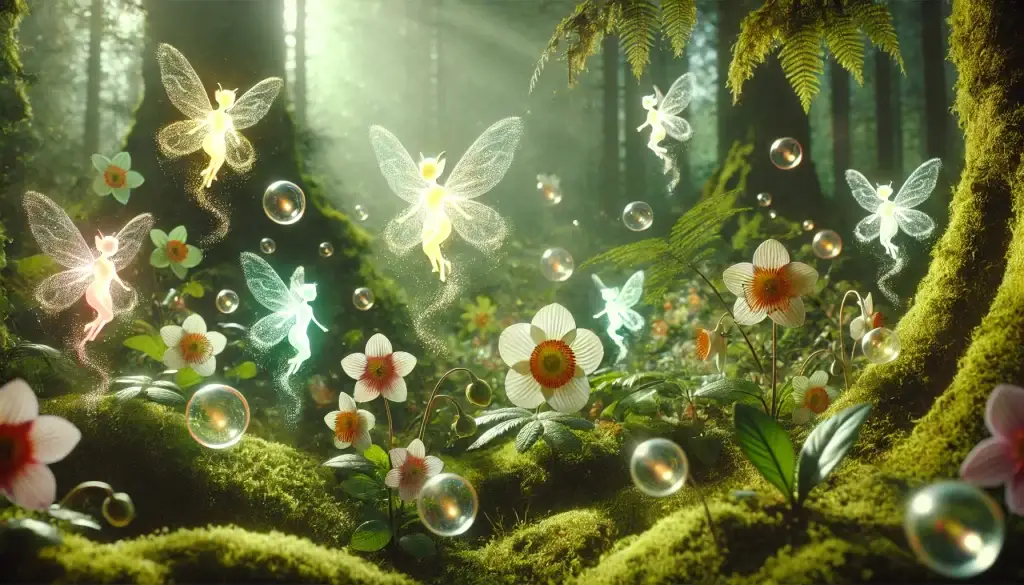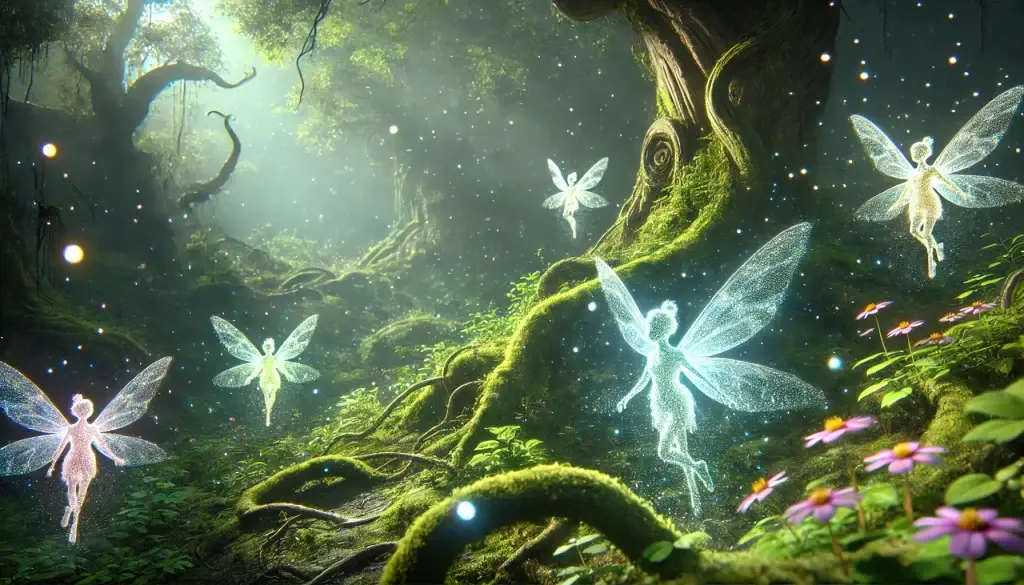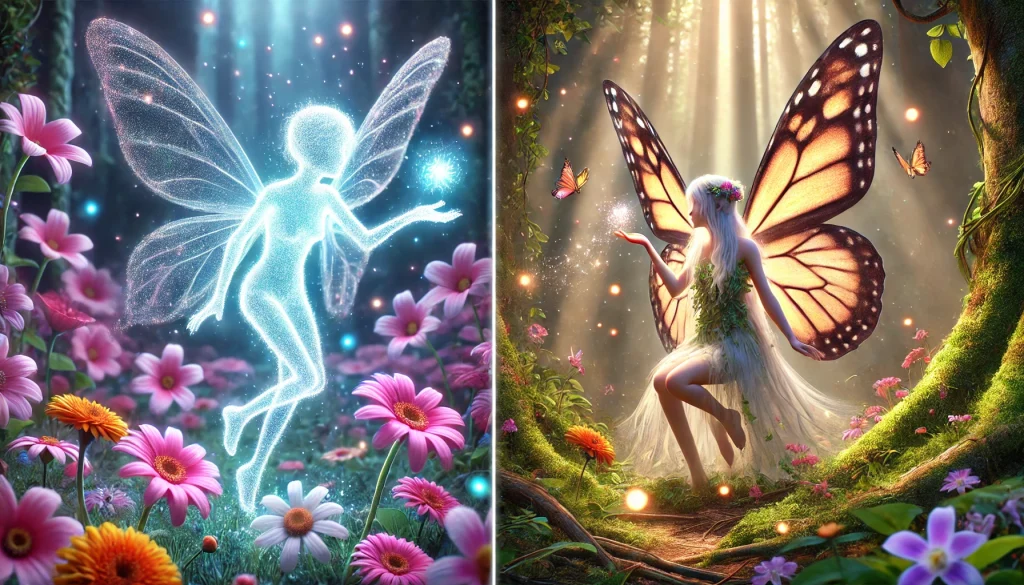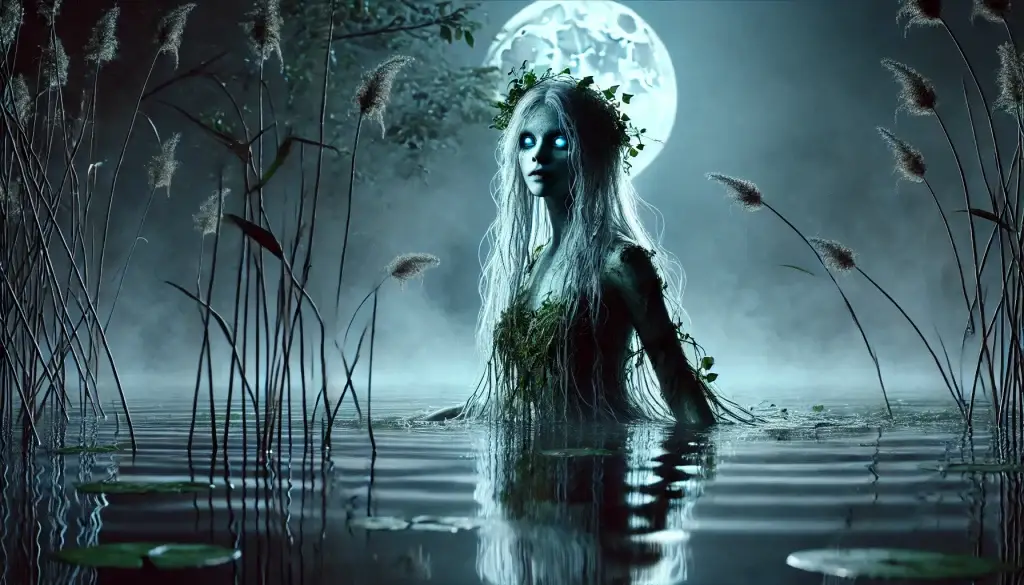Do you ever feel like something’s watching you from the corner of your eye while you’re walking through the woods? Or maybe you’ve caught a glimpse of a twinkling light just beyond the trees? Well, you might just have had a run-in with a sprite!
These mischievous little creatures have been flitting around folklore for centuries, and now we want to help you understand what they truly are. Let’s dive into the world of sprites – tiny guardians, pranksters, and nature’s magical ‘blink-and-you’ll-miss-them’ creatures.
Key Takeaways
- Sprites are Nature spirits. They are often associated with a specific part of nature, like trees, water, and wind.
- Sprites are different from Fairies.
- The Atomie, Pixie, Grib and Nixe are the four types of Sprites.
- The origin of Sprites can be traced back to ancient Greece.
Origin of the Sprite
The origin of Sprites can be traced back to the ancient Greeks, who used the word “Spiritus” to describe female nature spirits. The most popular among these female nature spirits are the nymphs, who were believed to dwell in rivers, lakes, or any freshwater.
Sprites have a very different meaning in Celtic, Scandinavian, and other Western European regions. They are tiny, bug-sized magical creatures that are associated with natural elements. Unlike the nymphs of ancient Greece, Sprites were not only associated with water. There were also trees, sprites, mountains, and strong wind.
What do Sprites Look like?

According to European folklore, spirits can appear in any form depending on the natural elements that are attached to them. Water sprites generally look like Mamaids with long hair and smooth skin, while mountain sprites look like tree spirits with rough brown skin.
Sprites are not necessarily female; there are also male Sprites. In the Shakespeare play “A Midsummer Night’s Dream“, the male character Puck, who interacts with the protagonist, is believed to be a Sprite.
Like the mythical fairies, sprites are also depicted with tiny butterfly wings that they use to move around. At night, they appear as tiny balls of light dancing around like fireflies.
Read Also:
Are Gnomes Evil? Everything you need to know.
Meaning of Owls In different mythologies from around the world.
Powers and Abilities of the Sprite
Sprites are pure magic. They are generally benevolent creatures that use their magic to help people; however, they can also punish those who disrespect nature.
It is generally believed that these creatures can not speak; however, they are very intelligent and can make themselves understood when they want to. Sprites are attracted to pure-hearted people. In folklore, they love to accompany heroes and advise them on their adventures.
Sprites also have control over any natural element they are associated with. Water sprites can control the water; forest sprites can use the forest’s magic, while wind sprites can control the wind.
Sprites remind us of the magic far away from our peering eyes and nosy bodies. All of which happens just beyond the veil of the everyday world.
Types of Sprites
There are four main types of Sprites, classified according to their size and behaviour.
Pixies

Pixies are probably the most well-known of the bunch and come straight from English and Celtic folklore. These tiny, winged creatures are usually described as playful, mischievous, and ready to cause a little trouble. But don’t worry—they’re harmless.
They love playing pranks on humans, like leading travellers astray or making their trip, but it’s all in good fun. Often found in the countryside, especially near ancient stone circles or in lush, magical forests, pixies have a close connection with Nature. They’re said to be dressed in green and have wings like dragonflies or butterflies, which allow them to dart around quickly.
Nixie
Nixies are water spirits that come from German and Scandinavian myths. Unlike pixies, these beings are much more mysterious and connected to rivers, lakes, and ponds. They can shapeshift, but they’re often seen as beautiful maidens with long flowing hair who lure people—particularly men—into the water.
It’s a bit of a cautionary tale, warning people not to trust anything by the water’s edge. In some stories, nixies are also described as having a more fish-like appearance with webbed fingers, scales, and a tail. They’re not always malicious, though; in some legends, nixies help humans.
Atomie

Atomies are tiny, even by fairy standards! These creatures are from English folklore and are considered to be some of the smallest fairies in existence. Despite their size, atomies are said to be full of life and energy.
They flit around quickly, barely noticeable to the human eye. Their roles in stories are usually very minor, often serving as attendants or messengers for other larger fairies. They’re not the troublemakers that pixies are, but their small size makes them excellent spies or prank helpers in the world of fae.
Grig
Grigs are another tiny type of fae, often depicted as even smaller than pixies but not quite as minuscule as atomies. From British and Scottish folklore, grigs are cheerful, lively little creatures that love dancing and playing music.
Grigs are notable for having the lower body of crickets and the uncanny talent of playing a fiddle.
They’re often found in groups, enjoying themselves in large, joyful gatherings. Their primary trait is their connection to fun and celebration, so if you ever encounter a grig in a story, they’re probably in the middle of a party or a dance-off!
Difference Between Sprites and Fairies

The table below shows the major differences between Sprites and Fairies.
| Sprites | Fairies |
| They are very small, usually thumb-sized. | They are larger and can be as big as a human. |
| They are associated with Nature, e.g. water or trees | They not associated with any natural element |
| They are guardians of nature. They protect the environment and ensure the well-being of plants and animals. | They can be helpful or mischievous and sometimes even play tricks on humans. |
| They can appear in several forms. Water sprites might look like mermaids and forest sprites might look like tree spirits. | They always appear as delicate humanoid creatures with wings. |
Other Nature Spirits In European Mythology
Vodyanoi – Salvic Water Spirits
Also known as “Grandfather” Water Sprites, Vodyanoi are immortal shapeshifting creatures that lure people into the water and drag them in to become their slaves. They keep the soul of these unfortunate beings and allow the body to flood to the top.
Some of the Vodyanoi have a human face, paws in place of hands, long horns, and eyes that glow in the dark. Others are men with red eyes, long noses and black skin. The Vodyanoi can be appeased by sacrificing a black pig.
Kelpies – Celtic Water Horse.
This is another shapeshifting water creature. The creature appears as a horse on the banks of a river and entices travellers and children to mount him. Once mounted, its skin becomes sticky, and it takes its rider into the deep water to drown.
Rusalkas-Water Spirit in Slavic Mythology

Rusalkas are winged female spirits of the water and woodland. In some myths, the Rusalkas are the spirits of women who die before marriage and become water sprites. In other myths, they are the unbaptized souls of dead children or the spirits of mortal youth who died by drowning.
The Rusalkas possess eternal youth, beautiful voices, and unusual powers. Rusalkas in the south are soft and gentle; those in the north are frigid and stern.
In summer, they reside in forests; in winter, they live in water. Some believe the Rusalkas live in certain green trees, which some believe are the homes of the dead.
The Rusalkas can be charming allies or harmful enemies. They hate absinthe and can be defeated with the leaf of the plant. They also have long green hair, which enables them to tickle mortals to death.